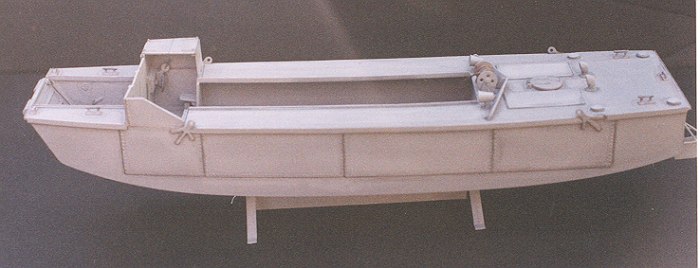
Fonderie Miniature 1/35 LCA
|
KIT # |
8002 |
|
PRICE: |
$64.95 ($58.97 at Squadron) |
|
DECALS: |
One Vessel |
|
REVIEWER: |
|
|
NOTES: |
Short run |

|
HISTORY |
 Next step; design a ship-to-shore-optimized landing boat able to carry a
useful number of battle-ready soldiers. It must be easily handled by
troop-carrying ships AND be simple enough to mass-produce and easily
maintain.
Next step; design a ship-to-shore-optimized landing boat able to carry a
useful number of battle-ready soldiers. It must be easily handled by
troop-carrying ships AND be simple enough to mass-produce and easily
maintain.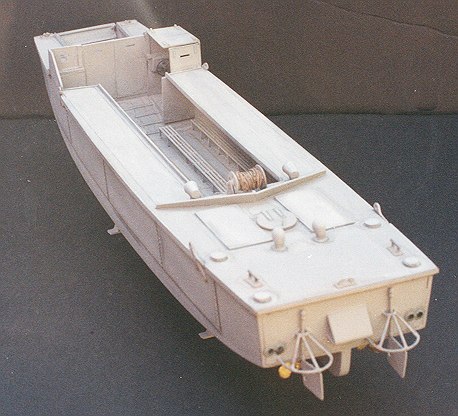 Sidebar: The US Navy put its native-designed Landing Craft Personnel (LCP)
in production about the same time. The LCP did not have the LCA's front
ramp or armour, troops having to embark / debark by climbing over /
jumping from the gunwales. Pics of "Higgins boats" at Guadalcanal and
North Africa show this not-user-friendly feature.
Sidebar: The US Navy put its native-designed Landing Craft Personnel (LCP)
in production about the same time. The LCP did not have the LCA's front
ramp or armour, troops having to embark / debark by climbing over /
jumping from the gunwales. Pics of "Higgins boats" at Guadalcanal and
North Africa show this not-user-friendly feature.|
THE KIT |
For a look at the bits in the box, please visit the preview.
|
CONSTRUCTION |
Y'know, gobs of folks have said it, but to reiterate, this is THE best
time to be a modeller, let alone a ship modeller! Alluva sudden, one
after another, kit subjects show up on the shelves, stuff you NEVER
thought you would see! Man, this is fine! Standing applause to Fondrie
Miniature for having the 'nads to take on this important subject.
Sidebar 2: Let's face it, we have all read / tolerated unlimited horror
stories about blah blah limited injection kits blah blah bad fit blah
blah rough finish blah blah gaps blah blah alignment blah blah lack of
detail.
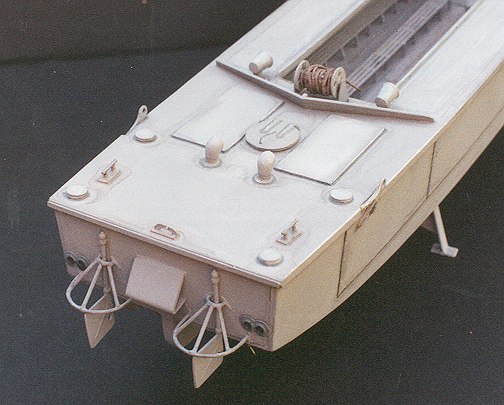 This kit was, after reading Scott Van Aken's in-box review and examining
the boxed contents...what are they bleating about? So what if it's not
Tamigawa shake n' bake?
This kit was, after reading Scott Van Aken's in-box review and examining
the boxed contents...what are they bleating about? So what if it's not
Tamigawa shake n' bake?
We are ship modellers, not girly-men!
'Discussed this with Great Kahuna / Editor Scott recently. It's about
SUBJECT, not snap-tite-ed-ness. What would these so-called-modelers have
done during the 30s and 40s with balsa sheet and block, tissue, newsprint
plans and no kits...or for that matter, NOW, with a Mamoli or even
Bluejacket ship "kit"? This crabby, middle-aged modeler's recommendation;
if the subject's desirability does not outweigh the miniscule bit of
traditional modeling skills and work needed with limited
injection...there are always your Barbies if you don't like sanding,
fitting and filling. (Though, admittedly, ship people seem the least
whiny of scale modelers.)
That said....'proceeded to use a Fine tungsten carbide sanding block to
true the flats and cut off the most offensive flash (and landing craft
have a bunch of flats) and got busy, as they say downtown.
The LCA was a fun build; this was a fascinating subject, a "voyage of
discovery," figuring out where everything went and what it looked like.
Fondrie Miniature's cast metal detail parts are first-rate, period.
Before the FM kit was available, if ya wanted an LCA, it was buy a pound
of Evergreen and Plastruct...and good luck finding ANY scale plans!
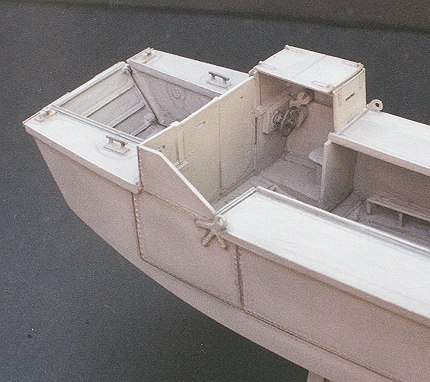 Assembly was sorta straightforward, though the kit was not built in the
steps a real boat would have been...and attempting to do so is not a good
idea. Follow the suggested sequence! The kit gives you one 8 1/2 X 11
double-sided photocopied sheet of exploded assembly views. These were
more than a tad vague, considering the relatively complex and unknown
subject.
Assembly was sorta straightforward, though the kit was not built in the
steps a real boat would have been...and attempting to do so is not a good
idea. Follow the suggested sequence! The kit gives you one 8 1/2 X 11
double-sided photocopied sheet of exploded assembly views. These were
more than a tad vague, considering the relatively complex and unknown
subject.
Test fit, test fit, test fit. Remember, test fit. Got it? And be
patient....
Mea culpa; this review builder made a couple of boo-boos which made his
assembly more difficult than need be; mainly by not following the
assembly sequence on the sheet. Thank Heaven, though, the relatively soft
yet strong Fondrie Miniature plastic is quite forgiving. The four benches
need about a hundred butt-joint vertical supports. Be patient...and make
a jig.
And feel sorry for the two poor guys stuck in the back of the boat, in
the engine compartment.
The kit REALLY looks like an LCA when built up.
Historic photos of LCAs do not seem to be prolific, and modeller beware;
the same sub-type is rarely seen. Some have D/F loops, others, Danforth
anchors on vertical racks forward. Hatch layout varies, as does the
placement and type of mooring bitts, chocks, cleats, fairleads and
gasoline filler caps.
|
CAMOUFLAGE & MARKINGS |
Primary colour per the instructions was given as "USN Grey." (Usually
fuzzy) photos showed anything from a light to darkish tone, so Pactra
Figure Primer, sprayed overall, was used as the base. It is sturdy and
accepts washes well. From there, well, chances are these boats were not
only not built like racing yachts, but not maintained like them, either.
Polly Scale USN Dark Gull Grey went over this nicely.
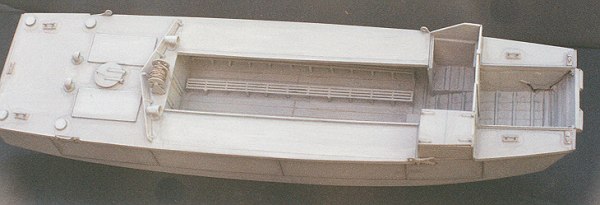 A wash of "tinted thinner" of black and raw sienna (thanks, Shep Paine)
was brush-slobbered on, blotted appropriately, allowed to dry thoroughly
and then the dry-brushing act began with ever-lighter greys. This kit was
treated as an armour subject both because of its scale and
"mass-produced-disposable" nature. Kit decals look okay but were not
used; intent is to hunt around for numbers and photos for the boats which
landed the 2nd Rangers at Normandy and mark the boat as one of theirs.
A wash of "tinted thinner" of black and raw sienna (thanks, Shep Paine)
was brush-slobbered on, blotted appropriately, allowed to dry thoroughly
and then the dry-brushing act began with ever-lighter greys. This kit was
treated as an armour subject both because of its scale and
"mass-produced-disposable" nature. Kit decals look okay but were not
used; intent is to hunt around for numbers and photos for the boats which
landed the 2nd Rangers at Normandy and mark the boat as one of theirs.
Then disaster struck. After carefully spraying on a clear coat of Tamiya
Clear Flat...EVERYTHING turned "crusty," like a windshield frosts over on
a December morning!!! Buddy Mike Hanlon, when solicited for emergency
assistance said, "Congratulations, you are the one-millionth modeler to
have his project spoiled by Tamiya Clear Flat. And don't use Gunze, it'll
do the same thing." Get out the Windex, wash the "clear" coat off AND THE
POLLY-SCALE PAINT WITH IT...and re-paint and re-weather, the same way,
but adding oil pastels and coloured technical pens into the final
process. Live and learn....
|
CONCLUSIONS |
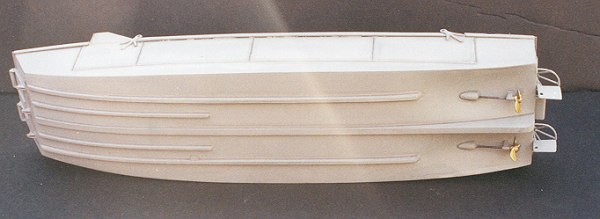 The Fondrie Miniature Landing Craft Assault is an important,
fascinating, long-overdue subject for the WWII modeler. Kit quality and
level of detail is extraordinary for a limited run injection kit and the
price is fair. The build took at least 50 hours, though my speed has
diminished over the years, and more in-practice builders could surely
improve on this...especially if they steer clear of Tamiya Clear Flat....
The Fondrie Miniature Landing Craft Assault is an important,
fascinating, long-overdue subject for the WWII modeler. Kit quality and
level of detail is extraordinary for a limited run injection kit and the
price is fair. The build took at least 50 hours, though my speed has
diminished over the years, and more in-practice builders could surely
improve on this...especially if they steer clear of Tamiya Clear Flat....
A few specs, courtesy of a reprint of a wartime Office Of Naval
Intelligence publication:
Length: 41'6" Beam: 10'
Draught: 1'1" fwd, 1'9" aft (light) 1'9" fwd. 2'3" aft (loaded)
Weight, empty: 9 tons Weight, loaded: 13 tons
Construction: Wood, 10# DIHT steel armor bolted to bulkheads and hull
sides, 1/4# doors
Engines: 2 Ford V-8 gasoline, 65 hp each, Range 50-80 miles
Fuel, gasoline 64 Imp gal.
Speed 10 kt (light), 6 kt loaded
Capacity: 36 troops and 800 lbs cargo
Crew: 4, with 1 officer per 3 boats
|
REFERENCES |
Allied Landing Craft Of World War II, Annapolis, Naval Institute Press
(1988) Reprint of Office Of Naval Intelligence publication. Includes a
few small photos and some specs.
British Commandos In Action, Carrollton, Squadron-Signal (1988)
Commando, New York, Ballantine Books, (1971), Peter Young
US Amphibious Ships And Craft, A Design and Development History.
Annapolis, USNI Press (2003), Dr. Norman Friedman
US Landing Craft In Action, Carrollton, Squadron-Signal, (2003), Al
Adcock
October 2003
If you would like your product reviewed fairly and quickly , please contact me or see other details in the Note to Contributors.